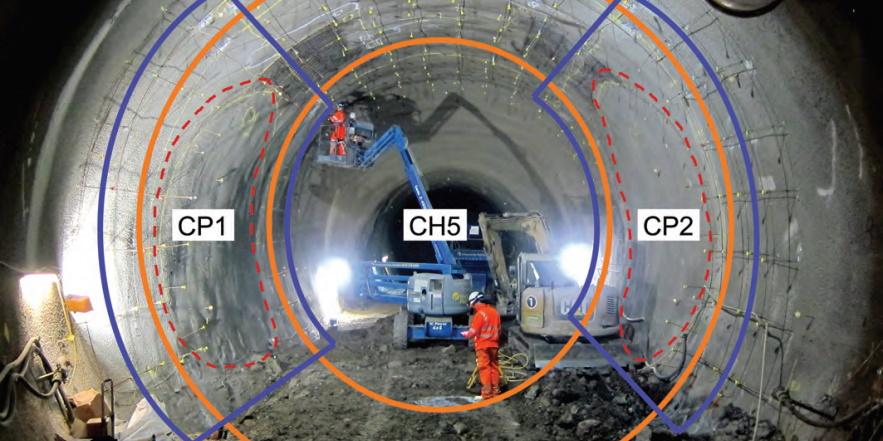
Original instrumentation at Liverpool Street station
In 2014, CSIC led ground-breaking work instrumenting and monitoring two junctions in a large sprayed concrete lined (SCL) tunnel with distributed fibre optic sensors (DFOS) to observe the changes in strain in the lining during the construction of cross-passages*. This was carried out at the Crossrail Liverpool Street station (Queen Elizabeth Line) in London to gather data on the behaviour of the tunnel lining during the breakout and excavation of the cross-passages. The goal was to produce reliable field data to investigate the accuracy of the 3D numerical models used to design the cross-passage junctions. In particular, the response of the reinforced thickening layer of SCL added at the tunnel enlargement chambers at cross-passage junctions was investigated with the aim of exploring the possibility of reducing material use and the associated carbon, which would also save time and money as well as enhancing safety during construction.
Designing SCL tunnels
SCL tunnels are challenging to design, especially the junctions, because of the complex material behaviour of the sprayed concrete and the ground, the multi-stage construction sequence and the dearth of available monitoring data from existing tunnels. The designers on the Crossrail project used sophisticated 3D numerical models to design these junctions but were aware of limitations in the modelling and some results did not tally with data collected from real tunnels. The resulting design was believed to be conservative in some respects which prompted the installation of the CSIC distributed fibre optic sensor system.
Understanding SCL performance from monitoring data
The DFOS monitoring data indicated that the load redistribution within the tunnel SCL during the cross-passage excavation was localised and significant changes in strain were limited to a relatively short distance from the cross-passage openings (1-2m) – smaller than the extent of the thickening SCL. These findings suggested that the need for thickening the SCL layer diminishes rapidly with increasing horizontal distance from the cross-passage openings. This implied that the tunnel enlargement chambers at crosspassage locations could be reduced in length, leading to safer construction and significant savings in material use. However, while the general observed mode of deformation matched expectations, the detailed pattern of recorded strain was not always consistent with design predictions and further research is required.
Closing the loop
To realise the full value of these high-resolution measurements, back-analyses and comparison of measurements with current design methods is required. A CSIC secondment project, which started in December 2020 with secondee Dr Alun Thomas, an established authority in sprayed concrete design and a member of the original Crossrail station tunnel design team, builds on the original research and aims to close this loop. With first-hand knowledge of the tunnel design, Dr Thomas has built a sophisticated 3D computer model of the junction to calculate the stresses and strains in the lining. New 3D models will be run to test the impact of possible enhancements of the modelling such as nonlinear behaviour of the concrete, bonding between sections of the tunnel and the bond of the lining to the ground. By comparing the 3D computer models with the fibre optic data collected in 2014, the research team, which includes CSIC researchers from the original instrumentation project, plans to investigate how to make the design predictions more accurate and to feedback into design guidelines.
Modelling and analyses
Most of the computer modelling has been completed and researchers are now analysing the results. At this early stage there appears to be better agreement between the more sophisticated design models and the measured results, indicating scope to improve the design methods, potentially leading to a reduction in the quantity of concrete and reinforcement required. The investigation has also revealed some limitations in the original monitoring as well as a number of unanswered questions about the design of the tunnels which lead from a tunnel junction (‘child’ tunnels). Researchers are looking for opportunities to instrument other tunnel junctions with DFOS and further computer modelling is planned to investigate the behaviour of child tunnels. Full results from this secondment will be presented in journal papers which are planned for submission during the second half of 2021, including descriptions of the comparison between current design methods and the original CSIC monitoring data and identification of areas for improvements and suggestions for better design methods.
Benefits to industry
Tunnels are an important part of major infrastructure such as Closing the loop: Back analysis of sprayed concrete tunnel junctions Thames Tideway, HS2 and the Lower Thames Crossing and SCL is a widely-used method. The tunnelling industry and the many sectors which use tunnels will benefit from improvements to the construction of cross-passage junctions since this will result in more economical use of materials including steel and concrete, a reduction in the associated embodied carbon, an improvement in construction safety and a reduction in project time and costs. In addition, a better understanding of the factor of safety in these structures enables the impact on neighbouring structures to be minimised, which is an important consideration when tunnelling in urban environments. With increased urbanisation internationally, improvements in the design of cross-passage junctions could provide benefits at scale.
Contact: CSIC secondee Dr Alun Thomas, MD of All2Plan Consulting ApS
Team: Professor Giulia Viggiani; Dr Mohammed Elshafie; Dr Alun Thomas; Dr Nicky de Battista Industry Crossrail Ltd; contractor BBMV JV; designer Mott MacDonald
Download the full case study here
*de Battista, N., Elshafie, M.Z.E.B., Soga, K., Williamson, M., Hazelden, G., Hsu, Y.S., 2015. Strain monitoring using embedded distributed fibre optic sensors in a sprayed concrete tunnel lining during the excavation of cross-passages. Proceedings of the 7th International Conference on Structural Health Monitoring and Intelligent Infrastructure (SHMII7). Torino, Italy.
